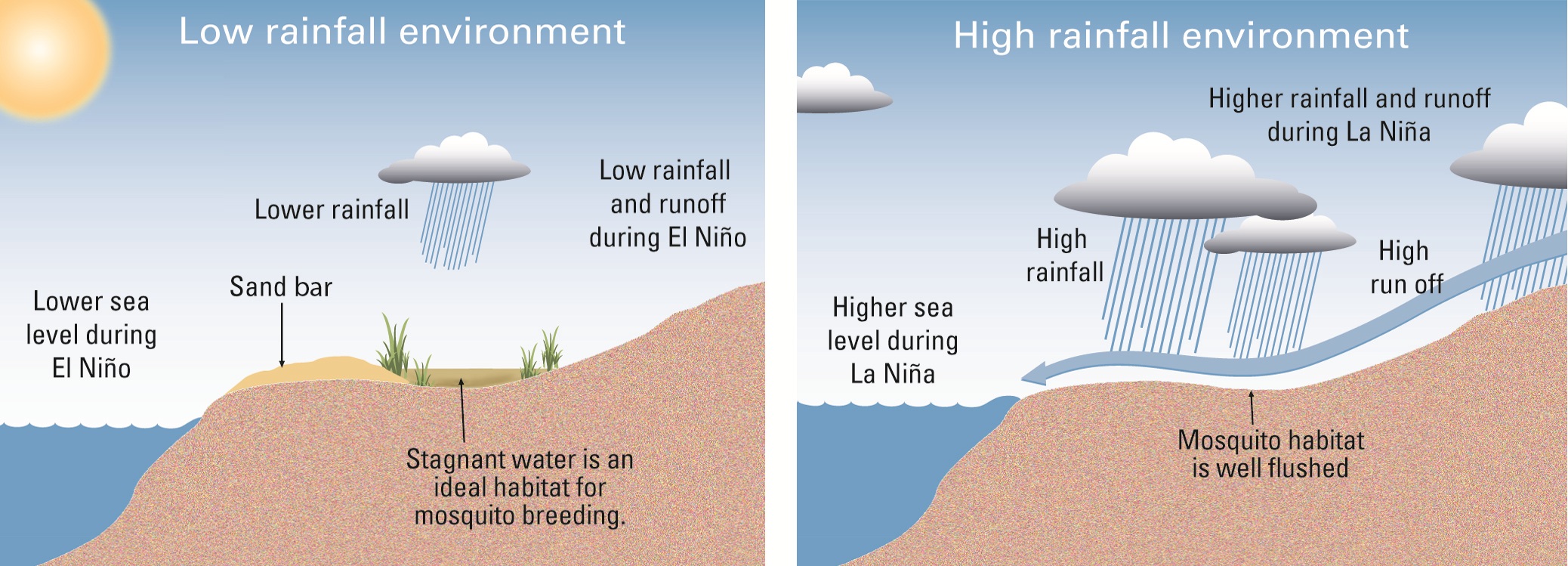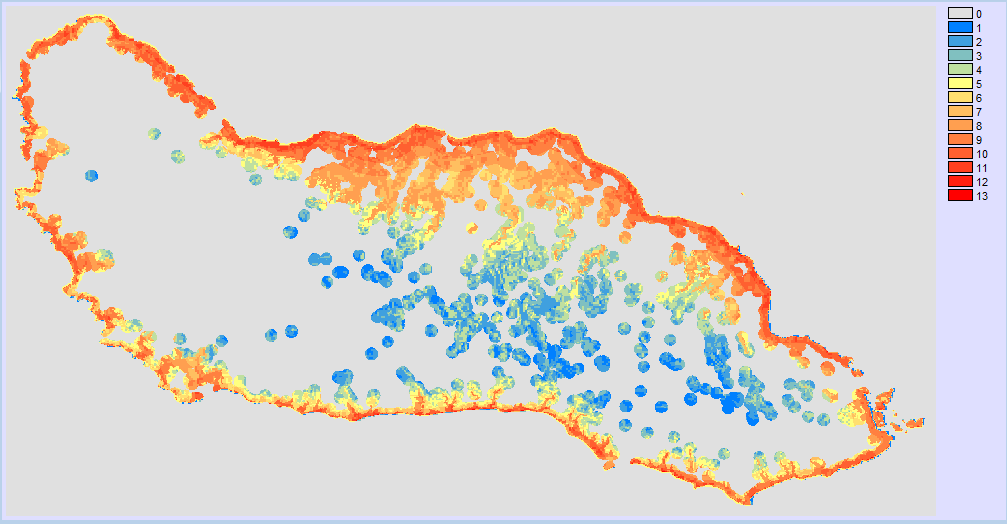A buzz in the air: Climate-based tools offer new hope for malaria prediction in the Pacific
08 December 2014
In a small corner of the Southwest Pacific, a ground-breaking project is using the latest seasonal climate forecasts to do battle against the world’s deadliest malaria parasite.
When the next ‘malaria season’ begins in the Solomon Islands in January 2015, a group of committed climatologists stretching from Australia across the South Pacific will be keeping a very close eye on local outbreaks of the deadly disease.
The group, under the auspices of the Bureau-managed Climate and Oceans Support Program in the Pacific (COSPPac), is developing predictive tools that use a range of long-term climate outlooks to evaluate the risk of malaria in the Solomons’ most populous islands.
As three-month seasonal rainfall outlooks and El Niño forecasts have become ever more accurate, the team has for the first time been able to develop a system for forecasting annual malaria risk. Their system combines rainfall outlooks with demographic data and the presence of brackish water where mosquito larvae breed.
The results are a Rainfall–Malaria Model and a series of detailed ‘Malaria Transmission Suitability Maps’ for the Solomons’ nine malaria-prone provinces. These tools have shown compelling accuracy in linking local rainfall patterns with malaria outbreaks spread by Plasmodium falciparum— the deadliest of four malaria parasites that infect humans.
An example of a Malaria Transmission Suitability Map for Guadalcanal Province based on ecological preferences of the main mosquito vector and the human settlements location
‘Our analysis of rainfall figures since 1998 has given us strong confidence that low rainfall associated with El Niño between October and December will result in a higher risk of malaria over the following six months,’ explains Jason Smith, a Bureau scientist supporting the COSPPac program. ‘On the other hand, normal or high rainfall between October and December generally results in a medium or lower risk of malaria.’
Across the Southwest Pacific, as in most tropical regions, the links between rainfall and malaria have long been documented: In the Solomons, there are still remains of pipes built by the British in the 1940s to drain brackish water into the ocean. But it is only now, with the advent of accurate three-month climate outlooks, that climate forecasting has become a practical weapon in the battle against malaria.
A model for regional replication
The development of a climate-based malaria monitoring and early warning system—or ‘MalaClim’, as the project’s lead scientist Dr Isabelle Jeanne calls it—is one of the key objectives of the current phase of COSPPac, which is funded by the Australian Government until June 2016. The pilot project was launched at a workshop in Honiara in September 2014. The workshop also attracted senior climatologists from Vanuatu and Papua New Guinea, whose governments are both keen to replicate the project.
In the Solomons, the MalaClim team is now fine-tuning and validating its Suitability Maps and the rainfall–malaria outlook for northern Guadalcanal and Central Province, which will be put to the test during the next malaria season between January and June 2015.
These islands offer a perfect baseline for the project. Not only do they account for about 40 per cent of the Solomons’ malaria cases, but on the most populous part of the island of Guadalcanal the links between rainfall and malaria are well understood.
In particular, researchers have found a compelling link between heavy rainfall and a low incidence of malaria in the following season. Unlike many tropical regions, where rain simply provides more water for mosquitos to lay their eggs, in northern Guadalcanal heavy rainfall initially generates positive conditions for mosquito breeding but then flushes the brackish streams where they breed into the sea. As a result, the prolonged heavy rain of La Niña years usually leads to a significant decline in malaria cases.

During lower rainfall periods, water forms stagnant pools providing optimal mosquito breeding environments. This varies season to season. During higher rainfall, stagnant pools are flushed, diminishing the quality of mosquito breeding environments.
The other factor that makes the Solomon Islands an ideal testing ground is the undoubted commitment of its government to the project. Over the past 18 months the Bureau has developed strong partnerships with the country’s National Vector-Borne Disease Control Program (NVBDCP) and the Solomon Islands Meteorological Service (SIMS), and the government is currently installing 16 new rain gauges next to health centres in the project area.
‘Together with Vanuatu, the Solomons have a real chance to become the first Pacific nation to successfully eliminate malaria in certain provinces,’ says NVBDCP Director Albino Bobogare. ‘Already, there is a very low level of malaria transmission in Isabel Province, and we have made good progress towards eliminating the disease in the southeastern province of Temotu.’
The frontline of the battlefield is now in the other provinces, where the concerted distribution of bed nets has resulted in the virtual eradication of two of the islands’ three mosquito species. The third, Anopheles farauti, has been found to be much more resilient, adapting to different breeding sites, travelling further afield, and even changing its behaviour to bite humans earlier in the day before they are under their bed nets.
MalaClim is thus focusing on farauti and its deadly cargo—the Plasmodium falciparum parasite—which is responsible for about two-thirds of the 45 000 malaria cases that still strike the islands each year.
Project team members from Solomon Islands National Vector-Borne Diseases Control Program COSPPac, and the Solomon Islands, Papua New Guinea and Vanuatu Meteorological Services
‘It is the parasite’s transmission that we have to target, not the mosquito,’ explains Dr Jeanne. ‘Even with spraying insecticide and clearing water around villages, it’s virtually impossible to get rid of the mosquitos entirely.’
The project is currently fine-tuning Suitability Maps for each of the Solomons’ provinces, overlaying data on their population centres, localised rainfall patterns, the presence of fresh and brackish water, and malaria data from local health centres.
The results will have multifaceted uses for the country’s busy NVBDCP managers—informing the continuing distribution of bed nets, the spraying of insecticide, the installation of further rain gauges, the draining of brackish water, and the delivery of diagnostic tools, treatments and public awareness campaigns.
‘This is the beginning of a long story,’ says Lloyd Tahani, Deputy Director of SIMS. ‘Health is one of the four priorities of the UN’s Global Framework for Climate Services, and we are delighted to have initiated such a strong collaboration between SIMS, the NVBDCP, and the Bureau of Meteorology to develop this important monitoring tool.’
More information
Email: COSPPac_COMP_Unit@bom.gov.au




Comment. Tell us what you think of this article.
Share. Tell others.